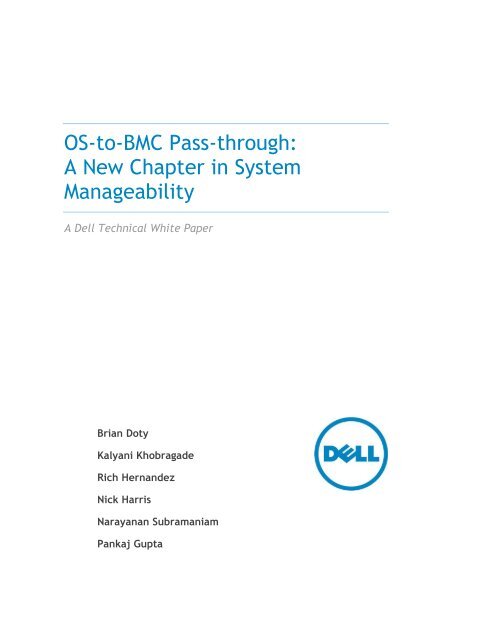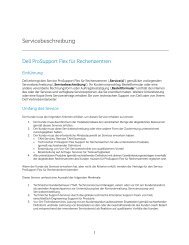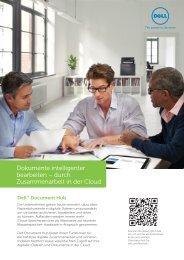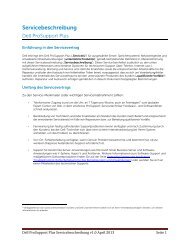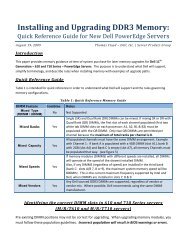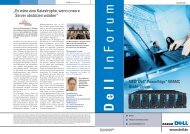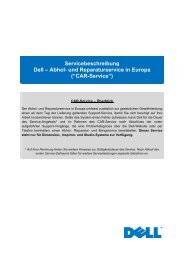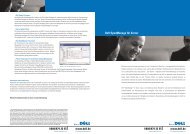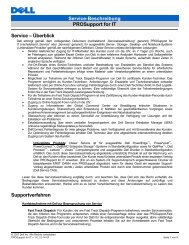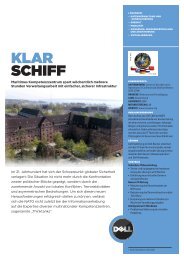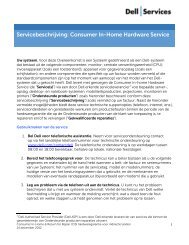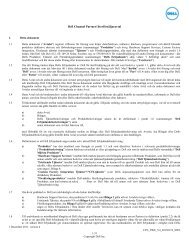OS-to-BMC Pass-through: A New Chapter in System ... - Dell
OS-to-BMC Pass-through: A New Chapter in System ... - Dell
OS-to-BMC Pass-through: A New Chapter in System ... - Dell
Create successful ePaper yourself
Turn your PDF publications into a flip-book with our unique Google optimized e-Paper software.
<strong>OS</strong>-<strong>to</strong>-<strong>BMC</strong> <strong>Pass</strong>-<strong>through</strong>:<br />
A <strong>New</strong> <strong>Chapter</strong> <strong>in</strong> <strong>System</strong><br />
Manageability<br />
A <strong>Dell</strong> Technical White Paper<br />
Brian Doty<br />
Kalyani Khobragade<br />
Rich Hernandez<br />
Nick Harris<br />
Narayanan Subramaniam<br />
Pankaj Gupta
<strong>OS</strong>-<strong>to</strong>-<strong>BMC</strong> <strong>Pass</strong>-<strong>through</strong> : A <strong>New</strong> <strong>Chapter</strong> <strong>in</strong> <strong>System</strong> Manageability<br />
Contents<br />
Abstract .................................................................................................................. 3<br />
The current paradigm .................................................................................................. 3<br />
The iDRAC7 solution .................................................................................................... 4<br />
Uses and benefits of the <strong>OS</strong>-<strong>to</strong>-<strong>BMC</strong> ................................................................................. 5<br />
A deeper look at the <strong>Dell</strong> solution ................................................................................... 5<br />
<strong>OS</strong>-<strong>in</strong>itiated traffic ..................................................................................................... 6<br />
iDRAC-orig<strong>in</strong>ated traffic ............................................................................................... 6<br />
Network configuration ................................................................................................. 6<br />
How <strong>to</strong> use <strong>OS</strong>-<strong>BMC</strong> ..................................................................................................... 7<br />
Conclusion ............................................................................................................... 7<br />
This document is for <strong>in</strong>formational purposes only and may conta<strong>in</strong> typographical errors and<br />
technical <strong>in</strong>accuracies. The content is provided as is, without express or implied warranties of any<br />
k<strong>in</strong>d.<br />
© 2012 <strong>Dell</strong> Inc. All rights reserved. <strong>Dell</strong> and its affiliates cannot be responsible for errors or omissions<br />
<strong>in</strong> typography or pho<strong>to</strong>graphy. <strong>Dell</strong>, the <strong>Dell</strong> logo, and PowerEdge are trademarks of <strong>Dell</strong> Inc. Intel and<br />
Xeon are registered trademarks of Intel Corporation <strong>in</strong> the U.S. and other countries. Microsoft and<br />
W<strong>in</strong>dows are registered trademarks of Microsoft Corporation <strong>in</strong> the United States and/or other<br />
countries. Other trademarks and trade names may be used <strong>in</strong> this document <strong>to</strong> refer <strong>to</strong> either the<br />
entities claim<strong>in</strong>g the marks and names or their products. <strong>Dell</strong> disclaims proprietary <strong>in</strong>terest <strong>in</strong> the<br />
marks and names of others.<br />
February 2012| Rev 1.0<br />
ii
<strong>OS</strong>-<strong>to</strong>-<strong>BMC</strong> <strong>Pass</strong>-<strong>through</strong> : A <strong>New</strong> <strong>Chapter</strong> <strong>in</strong> <strong>System</strong> Manageability<br />
Abstract<br />
This document describes the rationale and operation of the <strong>OS</strong>-<strong>BMC</strong> communication l<strong>in</strong>k available on<br />
the latest generation of <strong>Dell</strong> PowerEdge servers. The baseboard management controller (<strong>BMC</strong>) is a<br />
specialized service processor that moni<strong>to</strong>rs the physical state of a server. The <strong>BMC</strong>, runn<strong>in</strong>g specialized<br />
firmware, is responsible for moni<strong>to</strong>r<strong>in</strong>g the health of server components, ma<strong>in</strong>ta<strong>in</strong><strong>in</strong>g thermal<br />
characteristics, and aid<strong>in</strong>g <strong>in</strong> remote access and recovery. <strong>Dell</strong>’s <strong>BMC</strong> has evolved <strong>through</strong> several<br />
generations, expand<strong>in</strong>g its moni<strong>to</strong>r<strong>in</strong>g capabilities and remote access and add<strong>in</strong>g comprehensive<br />
remote management <strong>through</strong> the Lifecycle Controller. <strong>Dell</strong>’s current generation of <strong>BMC</strong> is known as the<br />
Integrated <strong>Dell</strong> Remote Access Controller 7 (iDRAC7). The iDRAC’s duties do not end at manag<strong>in</strong>g direct<br />
server management; the <strong>Dell</strong> OpenManage portfolio and other management consoles use iDRAC and<br />
Lifecycle Controller <strong>to</strong> simplify moni<strong>to</strong>r<strong>in</strong>g, deployment and updates.<br />
The <strong>OS</strong>-<strong>to</strong>-<strong>BMC</strong> pass-<strong>through</strong> is another example of <strong>Dell</strong>’s <strong>in</strong>vestment <strong>in</strong> iDRAC’s management<br />
capabilities, and <strong>in</strong> this case, fabric convergence. <strong>Dell</strong> supports network I/O convergence <strong>in</strong> numerous<br />
ways, such as FCoE and iSCSI. In addition, <strong>OS</strong>-<strong>to</strong>-<strong>BMC</strong> is another way <strong>to</strong> converge iDRAC traffic over the<br />
Ethernet network controller by leverag<strong>in</strong>g the LOM/NDC NC-SI communication channel. This provides<br />
many powerful capabilities for iDRAC and the management consoles that build on it.<br />
The current paradigm<br />
With the iDRAC7, the chipset is located on the server ma<strong>in</strong>board but is logically separate from the<br />
server platform and powered even when the server is off. Because of this, iDRAC7 is able <strong>to</strong> <strong>in</strong>terrogate<br />
the network <strong>in</strong>terface card (NIC) for configuration <strong>in</strong>formation, display it <strong>to</strong> an opera<strong>to</strong>r, and accept<br />
changes, all while <strong>in</strong> a pre-boot environment. These changes are subsequently s<strong>to</strong>red <strong>in</strong> non-volatile<br />
memory until a boot is <strong>in</strong>itiated and it is loaded <strong>in</strong><strong>to</strong> the NIC.<br />
There are two connectivity paths <strong>to</strong> the iDRAC. The first path is a remote connection over the LAN,<br />
where security pro<strong>to</strong>cols such as SSL are <strong>in</strong> place. The LAN <strong>in</strong>terface allows a user <strong>to</strong> access iDRAC<br />
remotely, even over WAN l<strong>in</strong>ks, directly access<strong>in</strong>g the iDRAC IP address. The <strong>OS</strong> <strong>in</strong>terface uses the IPMI<br />
pro<strong>to</strong>col over the <strong>in</strong>-band KCS channel.<br />
The second connectivity path is the KCS <strong>in</strong>terface. The KCS <strong>OS</strong>-<strong>to</strong>-iDRAC l<strong>in</strong>k is based on an <strong>in</strong>dustry<br />
standard <strong>in</strong>terface called Intelligent Platform Management Interface (IPMI 1 ). The<br />
<strong>Dell</strong> version of IPMI supports two <strong>in</strong>terfaces, one connected via LAN (IPMI over LAN) and one connected<br />
<strong>to</strong> the host server operat<strong>in</strong>g system via the Keyboard Controller Style (KCS) <strong>in</strong>terface.<br />
The KCS <strong>in</strong>terface provides unauthenticated local access <strong>to</strong> iDRAC but requires third-party software<br />
agents runn<strong>in</strong>g on the active <strong>OS</strong> system. The problem with this arrangement is two-fold: one be<strong>in</strong>g the<br />
presence of third party agents runn<strong>in</strong>g on the <strong>OS</strong> and two, the KCS channel is not very robust. KCS is a<br />
relatively slow <strong>in</strong>terface, us<strong>in</strong>g dual byte-aligned I/O ports, and is suitable for simple functions such as<br />
temperature moni<strong>to</strong>r<strong>in</strong>g, fan speed, or power status. The iDRAC uses this <strong>in</strong>terface <strong>to</strong> gather<br />
<strong>in</strong>formation about the operat<strong>in</strong>g system and its current state. However, more advanced functions<br />
require greater bandwidth and programmatic flexibility than currently offered by KCS. For example KCS<br />
does not have the bandwidth <strong>to</strong> access the iDRAC Web GUI directly on the host.<br />
1 http://www.<strong>in</strong>tel.com/design/servers/ipmi<br />
3
<strong>OS</strong>-<strong>to</strong>-<strong>BMC</strong> <strong>Pass</strong>-<strong>through</strong> : A <strong>New</strong> <strong>Chapter</strong> <strong>in</strong> <strong>System</strong> Manageability<br />
The iDRAC7 solution<br />
<strong>Dell</strong> saw opportunity <strong>in</strong> this problem paradigm and drove a solution <strong>to</strong> provide a robust l<strong>in</strong>k between<br />
the <strong>OS</strong> and iDRAC7. This was done by replac<strong>in</strong>g the KCS channel with a secure and high-speed<br />
management network us<strong>in</strong>g the onboard network adapter. S<strong>in</strong>ce the eighth-generation of <strong>Dell</strong><br />
PowerEdge servers, iDRAC has been able <strong>to</strong> use the embedded NIC for network access. This<br />
configuration is called shared mode. This mode allows you <strong>to</strong> m<strong>in</strong>imize network cabl<strong>in</strong>g by provid<strong>in</strong>g a<br />
path for iDRAC <strong>to</strong> share bandwidth with the onboard embedded NIC. The <strong>OS</strong>-<strong>to</strong>-<strong>BMC</strong> pass-<strong>through</strong> builds<br />
on this <strong>in</strong>terface. In this mode, the normal data path between <strong>OS</strong> and LOM/NDC is configured <strong>to</strong><br />
redirect management frames <strong>to</strong> the iDRAC. This technology takes advantage of the high-bandwidth<br />
standard network stack <strong>in</strong> the <strong>OS</strong> and provides a much more robust and standardized l<strong>in</strong>k for<br />
management traffic. Also, the hardware design supports select<strong>in</strong>g any of the LOM/NDCs ports that have<br />
a path <strong>to</strong> iDRAC. For those systems with more than one LOM, the solution provides maximum flexibility<br />
by support<strong>in</strong>g any of the LOMs as an <strong>OS</strong>-<strong>to</strong>-iDRAC communications channel. Only one LOM can be<br />
configured as the <strong>OS</strong>-<strong>to</strong>-<strong>BMC</strong> channel at a time, unless the LOMs are teamed. In this case the pass<strong>through</strong><br />
capability is enabled on all ports. All teamed ports must support <strong>OS</strong>-<strong>to</strong>-iDRAC pass-<strong>through</strong> and<br />
shared for iDRAC connectivity <strong>to</strong> be enabled. The communication channel between the LOM and iDRAC<br />
is the same NC-SI channel used for network <strong>to</strong> iDRAC communication. This is illustrated <strong>in</strong> Figure 1.<br />
Figure 1.<br />
<strong>Dell</strong> server communication diagram<br />
4
<strong>OS</strong>-<strong>to</strong>-<strong>BMC</strong> <strong>Pass</strong>-<strong>through</strong> : A <strong>New</strong> <strong>Chapter</strong> <strong>in</strong> <strong>System</strong> Manageability<br />
Uses and benefits of the <strong>OS</strong>-<strong>to</strong>-<strong>BMC</strong><br />
<strong>OS</strong>-<strong>to</strong>-<strong>BMC</strong> pass-<strong>through</strong> operation requires an active l<strong>in</strong>k on the network side of the shared LAN<br />
controller. This allows the network <strong>OS</strong> stack <strong>to</strong> use the LAN controller <strong>in</strong>terface for communications.<br />
The simplest advantage that this provides is <strong>to</strong> allow a user adm<strong>in</strong>istra<strong>to</strong>r seated at the server <strong>to</strong> br<strong>in</strong>g<br />
up a Web browser session <strong>to</strong> <strong>in</strong>terface with the iDRAC <strong>in</strong> that server. There are several other use cases<br />
described as follows:<br />
� The <strong>OS</strong>-<strong>to</strong>-<strong>BMC</strong> pass-<strong>through</strong> operation allows <strong>in</strong>-band WSMAN access <strong>to</strong> the iDRAC CIMOM and<br />
other web services as def<strong>in</strong>ed by DMTF.<br />
� It provides <strong>in</strong>-band <strong>OS</strong> access <strong>to</strong> iDRAC web browser for all system management functions. This<br />
allows cus<strong>to</strong>mers <strong>to</strong> avoid us<strong>in</strong>g a remote management client for local tasks.<br />
� The <strong>to</strong>ols used for <strong>in</strong>-band and out-of-band operation are consistent, as there is no need <strong>to</strong><br />
<strong>in</strong>vest <strong>in</strong> special <strong>to</strong>ols that depend on the slow KCS <strong>in</strong>terface.<br />
� It supports <strong>Dell</strong>’s goals of an agent-free environment by provid<strong>in</strong>g access <strong>to</strong> standard operat<strong>in</strong>g<br />
system management pro<strong>to</strong>cols.<br />
� It provides a fast and reliable communication path for the iDRAC <strong>to</strong> communicate status about<br />
server health and operation <strong>to</strong> the host operat<strong>in</strong>g system. It is not possible, for example, <strong>to</strong> use<br />
KCS <strong>to</strong> communicate complex power consumption statistics <strong>to</strong> the host <strong>OS</strong>.<br />
� The standard LAN <strong>in</strong>terface <strong>to</strong> the iDRAC <strong>in</strong>cludes security not present when us<strong>in</strong>g KCS. Us<strong>in</strong>g<br />
the <strong>OS</strong>-<strong>to</strong>-<strong>BMC</strong> technology, even a local user will be required <strong>to</strong> provide the appropriate<br />
authentication and security <strong>to</strong> communicate with the iDRAC.<br />
A deeper look at the <strong>Dell</strong> solution<br />
As mentioned earlier, iDRAC supports a shared mode <strong>in</strong> the LOM that serves as the basis for the <strong>OS</strong>-<strong>to</strong>-<br />
<strong>BMC</strong> technology. When the LOM is configured <strong>in</strong> shared mode, it provides L2 filters for the follow<strong>in</strong>g<br />
traffic flows based on dest<strong>in</strong>ation MAC Address and optionally VLAN ID:<br />
� <strong>OS</strong>-<strong>to</strong>-iDRAC<br />
� iDRAC-<strong>to</strong>-<strong>OS</strong><br />
� Network-<strong>to</strong>-iDRAC<br />
� iDRAC-<strong>to</strong>-network<br />
All forward<strong>in</strong>g decisions are based on L2 filter<strong>in</strong>g (dest<strong>in</strong>ation MAC and VLAN). NC-SI au<strong>to</strong>matically<br />
filters ARP, DHCP client, DHCP server, and NetBI<strong>OS</strong> broadcast packets. It also has specific filters for<br />
neighbor discovery and router discovery multicasts. For the outbound host traffic, NC-SI filter sett<strong>in</strong>gs<br />
are used for broadcast and multicast traffic. The same set of multicast and broadcast filters can be<br />
used for both <strong>in</strong>-bound network and out-bound host traffic <strong>to</strong> determ<strong>in</strong>e whether the packet gets<br />
forwarded <strong>to</strong> the <strong>BMC</strong> or not.<br />
5
<strong>OS</strong>-<strong>to</strong>-<strong>BMC</strong> <strong>Pass</strong>-<strong>through</strong> : A <strong>New</strong> <strong>Chapter</strong> <strong>in</strong> <strong>System</strong> Manageability<br />
For each of the packet-filter<strong>in</strong>g rules, the NIC management firmware <strong>in</strong>dependently configures whether<br />
the traffic is forwarded <strong>to</strong> the iDRAC or not. The execution of the follow<strong>in</strong>g NC-SI commands by the NIC<br />
management firmware results <strong>in</strong> forward<strong>in</strong>g the packet <strong>to</strong> iDRAC for the packet-filter<strong>in</strong>g rules:<br />
� Enable VLAN and set VLAN filter<br />
� Set MAC address<br />
� Enable broadcast filter<br />
� Enable global multicast filter<br />
<strong>OS</strong>-<strong>in</strong>itiated traffic<br />
Network I/O traffic from the host <strong>OS</strong> handled by an <strong>in</strong>terface enabled for <strong>OS</strong>-<strong>to</strong>-<strong>BMC</strong> pass-<strong>through</strong> is<br />
treated as follows:<br />
� The shared LOM will filter traffic com<strong>in</strong>g from the host.<br />
� If the dest<strong>in</strong>ation MAC address matches the iDRAC MAC address, it will forward the packet <strong>to</strong><br />
the NC-SI side band <strong>in</strong>terface for iDRAC process<strong>in</strong>g. Otherwise, it would send it out on the wire<br />
<strong>to</strong> the external network.<br />
� VLAN ID check can also be performed if provisioned<br />
� Broadcast and multicast packets should be sent on the side-band NC-SI channel and on the<br />
wire.<br />
iDRAC-orig<strong>in</strong>ated traffic<br />
Network I/O traffic from the iDRAC handled by an <strong>in</strong>terface enabled for <strong>OS</strong>-<strong>to</strong>-<strong>BMC</strong> pass-<strong>through</strong> is<br />
treated as follows:<br />
� The shared LOM will filter traffic com<strong>in</strong>g from the iDRAC.<br />
� If the dest<strong>in</strong>ation MAC address matches the <strong>OS</strong> side host MAC address known <strong>to</strong> the<br />
management firmware, it will forward the packet <strong>to</strong> the host <strong>OS</strong>. Otherwise, it would send it<br />
out on the wire. Broadcast packets are sent <strong>to</strong> the host <strong>OS</strong> and on the wire.<br />
� If the shared LOM is configured <strong>in</strong> the promiscuous mode, then all outbound <strong>BMC</strong> traffic shall<br />
be forwarded <strong>to</strong> the host.<br />
Network configuration<br />
The host and iDRAC can be on the same subnet, and therefore rout<strong>in</strong>g is not required. This supports a<br />
dedicated (static or DHCP) iDRAC IP address for the <strong>OS</strong>-<strong>BMC</strong> channel <strong>in</strong>terface unique per system and<br />
user configured <strong>to</strong> be on the same subnet as the host IP address.<br />
Alternatively, the host and iDRAC can be on separate subnets where rout<strong>in</strong>g will be required thorough<br />
the configuration of a default gateway. In this case, the host <strong>OS</strong> and iDRAC can communicate even if<br />
they are on separate VLANs or subnets because packets would go all the way <strong>to</strong> the router and then<br />
6
<strong>OS</strong>-<strong>to</strong>-<strong>BMC</strong> <strong>Pass</strong>-<strong>through</strong> : A <strong>New</strong> <strong>Chapter</strong> <strong>in</strong> <strong>System</strong> Manageability<br />
back. S<strong>in</strong>ce, iDRAC and the host are on separate VLANs, they would be on separate IP subnets, and the<br />
<strong>OS</strong> rout<strong>in</strong>g table would guide the IP layer <strong>to</strong> use default gateway <strong>to</strong> route <strong>OS</strong>-<strong>to</strong>-iDRAC packets.<br />
As with standard L3 rout<strong>in</strong>g, the dest<strong>in</strong>ation MAC address used <strong>in</strong> these packets orig<strong>in</strong>at<strong>in</strong>g from host<br />
would be router or default gateway MAC and not the iDRAC MAC. Similarly, packets orig<strong>in</strong>at<strong>in</strong>g from<br />
iDRAC would have the router MAC and not the host MAC address.<br />
These packets would go all the way <strong>to</strong> a router and get routed <strong>to</strong> the iDRAC <strong>OS</strong>-<strong>BMC</strong> VLAN/subnet. In<br />
both cases, the network <strong>in</strong>terface l<strong>in</strong>k must be up s<strong>in</strong>ce the <strong>OS</strong>-iDRAC channel is down when the<br />
Ethernet l<strong>in</strong>k is down.<br />
How <strong>to</strong> use <strong>OS</strong>-<strong>BMC</strong><br />
You can enable <strong>OS</strong>-<strong>BMC</strong> PT <strong>through</strong> the remote access controller adm<strong>in</strong> (RACADM) CLI, WSMAN, or IPMI<br />
command, and it can be enabled at the iDRAC, which will au<strong>to</strong>matically enable the LOM as well. The<br />
<strong>OS</strong>-<strong>BMC</strong> is not yet available with iDRAC’s dedicated NIC mode. Once enabled, you can simply launch a<br />
browser <strong>in</strong> the host <strong>OS</strong> (or guest <strong>OS</strong>) and connect <strong>to</strong> the iDRAC GUI.<br />
Conclusion<br />
The latest generation of <strong>Dell</strong> PowerEdge server and adapter technology is based on the foundation of<br />
mak<strong>in</strong>g server operation and management easier and more effective. The transition from 1 Gb <strong>to</strong> 10 Gb<br />
and beyond is symbiotic with the <strong>Dell</strong>’s current focus on consolidation and convergence. The <strong>OS</strong>-<strong>to</strong>-<strong>BMC</strong><br />
pass-<strong>through</strong> feature <strong>in</strong> <strong>Dell</strong> LOMs and NDCs is an example of these themes <strong>in</strong> action, which provides<br />
you with higher performance and enhanced usability.<br />
7


